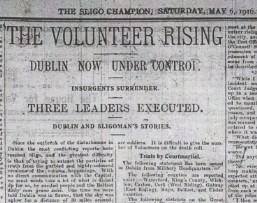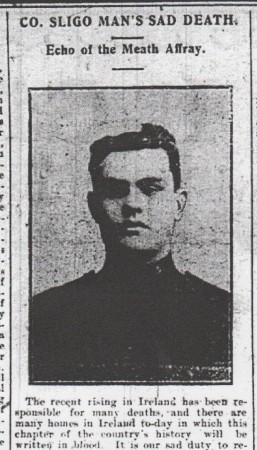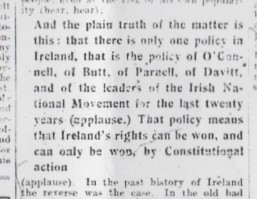Sligo 1916 - Sligo Poets
Main menu:
- Home
-
1912
- 1912
- Sligo Poetry 1912
-
1913
- 1913
- Sligo Poetry 1913
-
1914
- 1914
- Sligo Poetry 1914
-
1915
- 1915
-
Sligo Poetry 1915
- Sligo Newspaper Poems
- Sligo Champion
- Sligo Independent
- Sligo Nationalist
-
1916
- 1916
-
Sligo Poetry 1916
- Sligo Newspaper Poems 1916
- Sligo Champion
- Sligo Nationalist
- Sligo Independent
- The Poets
- Bibliography
- The Author
SLIGO 1916
During the early part of 1916 it was clear that there was some increase in support and activity in County Sligo for advanced nationalism, generally referred to as "Sinn Féin". At the end of the year the RIC County Inspector said of Sligo that ‘the Sinn Féin party were very active prior to the rebellion and were gaining adherents’. Other signs included blistering attacks on ‘factionists’ by County Councillor James McDermott and by South Sligo MP, John O'Dowd, in April 1916. (Right)
On St Patrick’s Day Irish Volunteer marched at Cliffoney, where fifty took part, at Ballymote, where sixty-


Volunteers in these three active areas mobilized in response to the original order at Easter 1916 but dispersed when no further orders were received and no actions took place in the county. After the Rising fifteen Volunteers were arrested in Cliffoney and one in Keash. Six were released at the end of May, the others were sent to Frongoch internment camp, north Wales. Twenty-
Reaction to the 1916 rising was quickly over-
As the Cliffoney prisoners were released in June, July and August they received warm welcomes in Sligo.
In the summer Lloyd George proposed bringing the postponed home rule bill into effect at once with the exclusion of six northern counties. Redmond and the IPP participated in negotiations believing that exclusion would be temporary. The Sligo Champion supported Redmond but resolutions against partition were unanimously passed by Sligo and Tubbercurry Boards of Guardians, Sligo Corporation and Sligo District Council.

In his report for June, the Sligo RIC County Inspector warned that ‘The sudden concern shown by the Government for home rule after the rebellion has strengthened the Sinn Fein party … No one seems pleased at the proposed partition of Ireland’. Redmond withdrew his support when it became clear that the northern Unionists had been assured that exclusion of six counties would be permanent.


Irish Party leader, John Redmond, visited Sligo on 29 October for the unveiling of a memorial outside the Post Office in the town, to P.A. McHugh, the former Sligo M.P. A large crowd attended and speeches supported the constitutional stand of the Irish Parliamentary Party. (Left, from Sligo Champion, 4 November 1916.)
In November a Sinn Féin club was officially established in Sligo town but this appears to have been a renaming of the well-
By the end of 1916 in Sligo, as elsewhere, the IPP had lost support and Sinn Féin had grown in popularity, but as yet it was not clear which side would take control of the nationalist movement.
The younger councillors, led by Dudley Hanley, who now controlled Sligo Corporation, had not yet decided which side to support. Events in the early part of 1917 would force them to make up their minds.